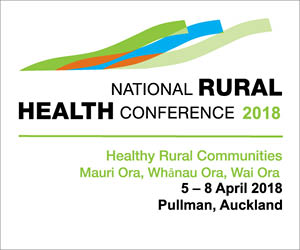Wairarapa’s nursing hero painted a mural to brighten the children’s ED cubicle in her home hospital before flying out to nurse for the Red Cross in South Sudan.
NAME: Jenny Percival
DHB: Wairarapa
JOB: Nurse educator, acute services and Red Cross nurse
Jenny Percival wears a number of hats. She is a nurse educator in acute services at Wairarapa Hospital, a humanitarian aid worker and a talented artist.
Currently she is wearing her Red Cross nurse hat and is nursing in the war-torn zone of South Sudan, which she left for soon after her local mission of brightening up the children’s cubicle in the emergency department with the pictured owl mural.
Jenny took up her nurse educator role at Wairarapa Hospital about a year ago, following 15 years as a staff nurse in the emergency department. She works with the nursing team in acute services to support, train and update staff on the latest developments and research in clinical practice and procedures. She assists new staff and graduates to develop skills and confidence and supports more experienced nurses to access opportunities to extend their knowledge. “It gives me great satisfaction to be able to support nurses to grow and develop,” says Jenny.
Jenny is also driven by a passion for humanitarian work. After training with the New Zealand Red Cross and their Red Cross partners in Switzerland, she worked on the front line in a treatment centre in Sierra Leone at the height of the Ebola epidemic. She says, “I feel the pull to make a difference where it’s needed most. If I can save one person from a life-threatening condition and that person survives, it creates a ripple effect.”
She is currently on a six-month mission with the New Zealand Red Cross (seconded to the International Committee of the Red Cross); part of a small surgical team at Juba military hospital, in South Sudan – the world’s newest country where civil war has been waging for more than 10 years. “There are three expat nurses and we look after two surgical wards and a small ICU with limited resources, including water.”
The biggest barrier though is communication. Jenny’s nurse educator skills are being put to good use as part of her job involves helping to train local nurses and nursing students who speak mainly Arabic, so teaching vital signs is a new challenge. There are plenty of other challenges too. “I have never seen so many limb amputations and it breaks my heart to see this, especially the young women and children with gunshot wounds,” Jenny writes from the war-torn zone.
No stranger to a challenge, Jenny will no doubt rise to meet it, much like the way she took on her own mission to brighten the children’s ward in acute services with a mural of colourful owls – just before she left for South Sudan. Jenny’s prime motivation was to make children and their families more comfortable in times of pain and stress. “Having something attractive with lots of points of interest provides a welcome distraction where parents can talk to their children about what the owls are doing,” she says.
Caring and humble, Jenny says she is “just an ordinary person doing something that feels like the right thing to do”.
Empowering her nursing team to make a difference in Canterbury’s older persons health and aged residential care sectors led to Gene Ruiz’s nomination.
NAME: Gene Ruiz
DHB: Canterbury
JOB: Clinical services manager and clinical advisor – Bishop Selwyn – Ultimate Care Group
When Gene Ruiz arrived in New Zealand in 2006, she thought working in aged residential care (ARC) would be just a stepping-stone to acute care nursing.
But a decade on she’s leading a team of eight registered nurses and empowering them to be the best after discovering not only an enthusiasm for older people’s health but ensuring professional development opportunities for her staff and quality improvements leading to better outcomes for her residents.
She was also shoulder-tapped in 2013 to be part of Canterbury DHB’s first gerontology acceleration programme intake – involving postgraduate study and ‘job-swapping’ between services – that aimed to fast-track potential nurse leaders in older people’s health.
Gene says she loves ARC because you develop a sense of family and friendship with residents, their families and staff.
“It’s like one big family. You get to know your residents and understand their needs more than you would working in an acute hospital setting. I really like that consistency and continuity of care we can provide.
“With our facility manager, Diane Topschij, and our nursing team… we seek to deliver the right care, at the right time, in the right place. In line with this, we empower our nurses and caregivers through continuing professional development, to enable them to deliver the right intervention at the right time in the right place.”
Gene says she’s noticed a shift in the type of admissions since the earthquakes.
“Thanks to more community services that are allowing older people to live longer in their own homes, we have noticed that when they do get to ARC, their dependency and acuity is much greater.
“Having a skilled workforce able to respond quickly and provide a much higher level of care and treatment is critical to this.”
Gene sees ARC’s place in the health system as one where increased acute and specialist care can be provided, without the need to admit patients to hospital.
“Our biggest achievement at the end of 2015 was the reduction in the numbers of acute hospital admissions, which was more than halved from 31 in 2014 to 12 last year.
“It’s a better outcome for everyone. It’s better for the resident, for their family and for the health system as a whole, but it relies on a skilled workforce.
“We encourage and provide our RNs the tools to further their knowledge and skills. We empower them to be involved in quality activities, like auditing, surveillance and trend analysis of the quality indicators, and letting the RNs take a champion area, such as falls prevention, to focus on.”
Gene says empowering staff now frees up her some of her time to help other clinical service managers across the Ultimate Care Group, in her role as clinical advisor, to implement similar changes in their facilities.
“I feel so proud to see our RNs so enthused and passionate in their work. We take pride in the service we provide and are happy to be able to make our mark in the lives of those we care for.”
Natalie is nominated for being “a hard-working, modest and truly professional nurse” whose wound care skills and leadership are making a difference to both the patients she cares for and the nursing colleagues she supports in building their own clinical skills.
NAME: Natalie Scott
DHB: Capital & Coast
JOB: Clinical nurse specialist, wound care
Patients previously nursed in hospital beds are now regularly supported at home due to the expert assistance Natalie Scott provides both the patient and her nursing colleagues.
Natalie is a clinical nurse specialist for wound care with Capital & Coast’s district nursing service and supports the development and improvement of wound care practice for her 60 district nursing colleagues, many aged residential care nurses and other nurses in the community sector who have patients with complex wounds.
The board says her warm and approachable manner enables others to gain expertise in complex wound management and she aims to empower nurses with evidence-based literature, guidelines and processes to support best practice including ‘one-on-one’ case collaborations, face-to-face teaching sessions and electronic learning tools.
Measuring wound care outcomes has been an ongoing mantra for Natalie. To assist her and her colleagues in this she introduced to the service the New Zealand-developed 3D wound-measuring laser tool and documentation system, known as the Silhouette, to promote the routine collection of wound data during the treatment and healing process. As a result, nurses can now quantify their patients’ wound healing speeds and Natalie reports that their results compare very favourably with national and international outcomes.
Through her personal enthusiasm and collaboration she also in 2011 initiated a leg ulcer clinic in a high health need area, in partnership with a local Māori PHO. This targeted clinic continues to provide specialist wound care integrated with GPs, podiatrists, practice nurses and other health professionals. The aim of the clinic is to support the development of the primary health care team and grow the connection between specialist nursing services and general practice. Also by bringing expert care closer to a hard-to-reach population, the clinic helps avoid referrals to vascular specialists and unnecessary hospitalisations plus enabling faster healing rates of long term chronic wounds.
Natalie also works hard helping to develop local, national and international wound care practice standards and maintaining her own professional development.
Liz Read is nominated for her work as a stalwart champion of public health from her career outset – while at the same time wearing a number of leadership hats.
NAME: Liz Read
DHB: Hawke’s Bay
JOB: Nurse manager for public health nurses
Some nurses want the buzz of ED, others the precision of theatre or the hustle and bustle of wards but from the outset Liz Read has always wanted to nurse in the community.
Even when she started her nursing career, more than 30 years ago in Napier Hospital’s paediatric ward, she already had her heart set on working beyond the hospital walls.
“I saw it as a stepping stone to public health which has always been my passion,” says the nurse who for the past four years has been the district health board’s nurse manager for public health nurses and also wears several other community health leadership hats.
“Our team is involved with traditional nursing but from a public health perspective – child health such as skin infections, immunisation, managing communicable diseases like TB, measles, mumps, meningitis and hepatitis, and adolescent health,” she says.
“We’re focused on health promotion, prevention and early intervention, and work predominantly in communities disadvantaged by lack of income, poor housing and unemployment,” says Liz. “Trying to influence the distribution of resources and improve health-related policy is a key objective of public health nursing, whether this be canteen or nutrition policy in schools, smokefree areas, child safety legislation, or supporting teachers in their delivery of the health curriculum.”
Liz also manages the sexual health service and is proud of the closer relationship forged between primary and secondary care over the last four years that has led to an improved service and increased access to free services. The establishment of a dedicated sexual assault service has also made a big difference, she says.
After four years in her public health leadership role Liz says she now has the confidence to put a public health perspective firmly on the agenda at management meetings, which are often focused on hospital services.
“As resources get tighter and demand on services greater, I’ve become more passionate about making sure we’re efficiently delivering services where the highest need is, while never losing our public health focus.”
Recently seconded to the role of acting manager at Napier Health, she says the extra workload is made easier by her great multi-disciplinary team of 45.
The married mother of three children – two boys and a girl aged between 14 and 20 – is also coordinator of the child and youth mortality review group for Hawke’s Bay.
“It’s a no-blame review process to improve systems and prevent further deaths – things like our suicide prevention strategy, and safe sleeping action plan have come out of it,” she says.
HBDHB chief nursing officer Chris McKenna says, “Liz is a proactive, pro-nursing leader. She leads many projects and initiatives, but is always looking at ways in which nursing practice can be advanced to deliver better care to the community.”
After an eclectic nursing career, Diane Williams became an NP as she wanted to help offer the best access to healthcare. Nearly a decade later, she remains committed to doing just that.
JOB: Diane Williams
DHB: Nelson-Marlborough
JOB: Nurse practitioner (primary health care)
After an eclectic nursing career, Diane Williams became an NP as she wanted to help offer the best access to healthcare. Nearly a decade later, she remains committed to doing just that.
Diane Williams reckons she’s been around nursing long enough to reinvent herself a few times. She’s worked in ED, theatre, ski patrol, schools and in industrial, rural and occupational nursing roles.
Originally trained in Sydney, as her nursing experience grew Diane developed a focus on remote rural and community nursing. She moved to New Zealand over 25 years ago and has developed a wealth of experience looking after health needs in rural communities.
While she was living in Te Araroa, on the East Cape, Diane started her clinical master’s in nursing and was later interviewed by the Nursing Council to gain accreditation as a nurse practitioner.
“Te Araroa means ‘long pathway’ in Māori and that was quite appropriate at the time,” says Diane. “However, I wanted to have the best capability and offer the best access to healthcare so it started me on a journey.”
Diane looks back now at the study and time involved and wonders how she managed it. “I must have been mad – I had a young family, I was doing a variety of positions and doing call-outs at night.”
Despite this, Diane remains committed to the primary care nursing speciality.
“It’s cradle to grave and dealing with everything that walks in the door,” she says. “You are in a very privileged position – being involved in people’s lives and helping to make positive outcomes.”
Diane believes primary health professionals have many opportunities to change not just one person’s life but whole families and communities. She says the nurse practitioner role is successful in many locations and is becoming well accepted.
“For instance, on the West Coast the nurse practitioner role is part of a general practice team and is well accepted by patients.”
Late last year Diane became the first NP to work at the Marlborough After-Hours GP service. She’s been registered as an NP for over nine years and is one of only two working in Marlborough.
Lorraine Thompson-Aramoana started her nursing training to fill in time until she was old enough to apply for the police force. But she became hooked and nearly 40 years later is nominated as a hero for her passion and leadership in older people’s health.
NAME: Lorraine Thompson-Aramoana
DHB: Auckland
JOB: Charge nurse, older people’s health
The police force was Lorraine Thompson-Aramoana’s first career choice but nursing was her destiny.
She had already been accepted into police training when fate intervened and the police force entry age was raised. Her friend encouraged her to ‘give nursing a go’ instead.
“My intentions were to reapply for the police when I was old enough, but after my first two years of nursing, I thought it would be ridiculous, given what I’d enjoyed so far,” recalls Lorraine.
Lorraine describes herself as a home-grown nurse, beginning her training at Auckland City Hospital in 1977, and registering in 1980. She became a charge nurse within seven years in general medicine before moving into orthopaedics and working with the frail and elderly.
“I was able to share and develop my skills from general medicine to support the older population, who were becoming quite unwell with delirium and falling. It was a natural progression to work in older people’s health where I was involved in various projects.’
One of these more recent projects was the ‘falls concept ward’ at Auckland City Hospital, which aimed to reduce falls causing harm for the vulnerable, older population.
“It was really positive to work with other nursing, medical, quality and safety staff, and important that everyone on our ward had a shared understanding of what we wanted to achieve.”
Initiatives introduced included coloured mobility wristbands, a confusion screening tool and improved toilet signage as well as increased awareness amongst staff of bed positions, patient toileting needs, pain and medication levels and post-fall review processes. The successful project is now in place on other wards.
Lorraine’s holistic approach to nursing leadership is also admired.
“It’s important to recognise everyone and support them to rise to challenges. I try to make sure staff have a shared understanding of the wider context and why we do what we do. Reminding them of even the small things, remembering people’s names, saying hello with a smile and reminding patients of who we are.”
Outside of work she is a former netball player and now referee and has never stopped learning. In 2007, not long after receiving the Trophy of Tradition for nursing professionalism, she completed her master’s in health sciences with a dissertation focused on cultural competence and its impact on the quality of care.
“There are so many in nursing who deserve to be a nursing hero. I don’t see myself as being any more special than anyone else who puts the effort in, in what they believe and enjoy. I’m fortunate in that I’m here because I choose to be here, I’m supported to be here and I’m here to stay.”
Next year, Lorraine celebrates 40 years of nursing and 30 years as a charge nurse.
Rising to the challenge of a project to develop Whanganui’s stroke service – a specialty area new to her – won Amanda Van Elswijk the Whanganui nursing hero nomination.
NAME: Amanda Van Elswijk
DHB: Whanganui
JOB: Clinical nurse manager AT&R and acute stroke unit
Rising to the challenge of a project to develop Whanganui’s stroke service – a specialty area new to her – won Amanda Van Elswijk the Whanganui nursing hero nomination.
Amanda Van Elswijk’s career took a sharp turn in 2012. Following many years working as a paediatric, neonatal and public health nurse, she was asked to lead the Whanganui DHB’s stroke service development project. It was a challenge she rose to and, four years on, Amanda is making her mark on stroke services and has fully embraced her new specialty.
In 2014, she was instrumental in establishing Whanganui Hospital’s acute stroke unit in the assessment, treatment & rehabilitation (AT&R) ward. So rather than the traditional path of acute stroke patients being treated in medical wards and then being transferred to ATR, they are now admitted straightaway to a unit within ATR.
Amanda says the new approach is proving successful, with a stroke patient’s rehabilitation beginning as soon as they are admitted to the acute stroke unit.
Amanda and her team were determined to provide an acute stroke unit where people of all ethnicities feel comfortable, so they are guided by Mason Durie’s Te Whare Tapa Wha* model of care, which describes concepts of health and wellbeing from a Māori perspective.
Amanda stresses to her staff how important it is to understand and empathise with stroke patients and their families.
“When a person has a stroke their lives can change irrevocably,” Amanda says. “They might be with us for three to four months and almost overnight, they (and their family) might have to come to terms with knowing they may never work again, that their house will need to be modified and they may struggle to speak.
“They have so much to take in and there are times when stroke patients’ behaviour can be challenging. So to address this, I and my team have done a lot of training to learn about grief, loss and change; how a patient is feeling and how to adapt their care plan around that,” says Amanda.
“From the moment a patient enters our acute stroke unit, their rehabilitation begins and that can be very challenging for some people. Our job is to help them achieve the best recovery possible and I’m confident that we are doing this. The results we’re getting point to that.”
Besides her work in the hospital, Amanda sits on local, regional and national working groups for stroke and has been instrumental in developing services for primary, and well as secondary care, of stroke patients.
She’s currently completing her clinical master’s degree, with her research component focused on caring for stroke patients. Amanda also heads up the Map of Medicine for stroke, which sees her working closely with the Whanganui Regional Health Network, GPs, and St John Ambulance, among others.
*Te Whare Tapa Whā compares health to the four walls of a house where all four walls (the psychological, physical, spiritual and family/whānau dimensions of health) are necessary to ensure strength and symmetry.
Counties Manukau’s nursing hero is nominated for her work in making her mark not only in Middlemore’s critical care services but across the Pacific in Samoa.
NAME: Jenny Stewart
DHB: Counties Manukau
JOB: Associate charge nurse manager, critical care complex
Counties Manukau’s nursing hero is nominated for her work in making her mark not only in Middlemore’s critical care services but across the Pacific in Samoa.
Jenny Stewart has worn several hats in the past decade but they all have a common theme of striving to develop and improve critical care nursing.
In April 2014 the DHB’s critical care complex (covering Middlemore’s intensive care and high dependency units) was asked to go and review the critical care services for the intensive care unit at Tupua Tamasese Meaole Hospital in Samoa’s capital Apia. This led to 12 months’ work with the Apia ICU supported by funding from the Regional Pacific Health Development.
Jenny led this programme of work with the board saying she demonstrated excellent leadership with her organising, networking and team-building skills, along with her excellent powers of persuasion. The result was she has created what has been described as a very robust network of people, both at Counties and in Apia, who are passionate about improving healthcare outcomes in Apia’s ICU, through developing staff skills, by offering training and education, but also through ensuring the provision of ICU equipment is reviewed to enable staff to better assist in providing high quality care.
The DHB says her leadership both in New Zealand and Samoa has been a real credit not only to her but also to the critical care complex. It hopes to continue building on Jenny’s foundational work in the years to come to assist in the development of intensive care nursing in Samoa. Counties Manukau Health has been working with countries in the wider Pacific region since 2002 when it signed its first memorandum of understanding with the Cook Islands. The Ministry of Foreign Affairs and Trade (MFAT) funds the DHB to provide services to a number of Pacific countries which now also include Samoa, Niue, Fiji and Kiribati.
Retiring enrolled nurse Val Scott is nominated for her quirky sense of humour, patient-centred care and the invaluable work she puts in on DHB committees and working groups as an NZNO representative.
NAME: Val Scott
DHB: Bay of Plenty
JOB: Enrolled nurse, acute surgical ward (retired)
Retiring enrolled nurse Val Scott is nominated for her quirky sense of humour, patient-centred care and the invaluable work she puts in on DHB committees and working groups as an NZNO representative.
Tauranga Hospital’s Ward 3c says it will miss Val Scott’s dedication to quality patient-centred care and her quirky sense of humour. Val recently retired from Bay of Plenty District Health Board – after 27 years’ service as an enrolled nurse and many years working as a New Zealand Nurses Organisation representative and delegate – to return to her hometown of Gisborne.
During her years at the board she was also known for her dedication to communication and collaboration developments. Val was an inaugural member of the NZNO team who were trained in using the coaching model to work in partnership with DHB management. She worked as part of the joint action group (DHB/NZNO partnership) that aimed to improve the journey for both nurses and patients, and was also an active member of the NZNO enrolled nurses section, northern region PDRP Council, discretionary sick leave panel, and the falls prevention group. The board says Val was also an invaluable support for nurses as an NZNO delegate, guiding them through sometimes sensitive issues.
But most of all the board thanked her for the excellent care she gave to thousands of patients throughout her working career, saying Val’s caring and professional expertise helped many people through their nights in hospital that could otherwise have been very quiet, lonely and scary.
Free head and shoulder massages, fruit packs and quit smoking support have been offered at health promotion days organised by Amanda Shanley with the aim of improving the physical health of Waikato mental health service clients.
NAME: Amanda (Mandy) Shanley
DHB: Waikato
JOB: Clinical nurse specialist, mental health and addictions
Free head and shoulder massages, fruit packs and quit smoking support have been offered at health promotion days organised by Amanda Shanley with the aim of improving the physical health of Waikato mental health service clients.
A holistic health initiative by clinical nurse specialist Amanda Shanley is making a difference for mental health service users in Hamilton.
Amanda was appointed to the role of clinical nurse specialist mental health in March 2015, from a background of working with service users diagnosed with eating disorders.
“I have always been passionate about holistic health care and after researching global initiatives I started raising awareness across mental health teams about the alarmingly reduced life expectancy of people with a serious mental illness.
“The ultimate aim is to increase the life expectancy and quality of life of the service users that we work with,” she says.
Using the umbrella of Equally Well (a Te Pou initiative) and with “amazing support” from the community clinicians, Amanda and her colleagues held two nurse-led health promotion days at the Hamilton community mental health service base last year.
The first event saw over 50 service users and their whānau take up the opportunity to discuss their concerns on smoking and trialling a nicotine replacement therapy (NRT). Free packs of fruit, other healthy snacks and signed quit cards (to access free NRT) were given out to all who attended.
One of the positive spin-offs of this initiative was much stronger mental health clinician engagement in seeking advice and NRT support for their clients who smoke.
Next, Amanda linked with secondary, primary and NGO services and Sport Waikato to turn on a ‘Treat yourself for Christmas, look after your health’ event. With live music, balloons, free fruit and gift baskets, free head and shoulder massages, and health promotion stalls, the outside event got an extremely positive response.
“It was a relaxed setting where service users, whānau and clinicians could share simple strategies for improving physical, mental, emotional and spiritual health – holistic health.”
This success means the holistic health initiative will continue into the future, with strong support from those involved and the mental health service’s senior leadership team.
Carole Kennedy, nurse director of Waikato DHB mental health & addictions says, “The initiative illustrates Amanda’s commitment and dedication to mental health and addiction service users and to making a positive difference to their lives”.
The call of the waves nearly saw Kim Tito give away nursing training for an extended surfing OE. But he returned to start a four-decade health career – including the championing of Māori health – and recently resigned as Northland DHB’s general manager of Māori health and mental health & addiction services.
NAME: Kim Tito
DHB: Northland
JOB: General manager, Māori health and mental health and addiction services (retired)
Champion for Māori health Kim Tito ended his time with Northland DHB in February with a moving whakawatea (farewell), 44 years after he originally joined the organisation from school.
He began as a pay clerk and left as Northland DHB’s general manager of Māori health and mental health and addiction services, with his resignation reflecting a consciousness of his health and an appetite for new challenges. “It’s my decision to finish at this juncture and time for me to explore a different awa [river] on a different waka.”
Kim says his family has “a torrid history” of men dying at relatively young ages. “My dad and all his brothers died before they reached 60, so making it to that age has been a goal for me.”
Now 61, he says, “Stopping this job and doing something different should give me the opportunity to do the things I really want to do. Jenny [his wife] and I are setting ourselves up for the next couple of decades.”
However, he expects to maintain some involvement with the health sector and the national, regional and local networks he has built up.
Kim was the first man to gain his registered nursing qualification in Whangarei in 1976. However, after applying and being accepted for nursing, he instead left New Zealand on a surfing OE with a mate, starting in Queensland.
“I met this hippy guy under a palm tree who was sleeping rough and he convinced me that I should go back to New Zealand and get started on my training, so I gave up following the waves.”
Although his decision to train as a nurse raised eyebrows at the time, Kim believes the health sector is a fantastic environment for people to work in if they are motivated by helping others. “The opportunities are unlimited really – it’s a great career destination for men, particularly as a nurse.”
Reflecting on developments since his own training, Kim says the education of nurses has changed quite dramatically and the process of nursing has also changed. “I can remember the first intravenous drips coming in and having to learn how to operate them. Nowadays there is all sorts of technology that nurses have to learn about and operate successfully.”
“But the relationship that nurses need to foster when they meet people for the first time, and build some sort of trust and rapport with the individual and family or whānau, is still the same.
“Having personally been a patient a number of times in bed, it’s very easy to identify those people who have a very genuine desire to listen and develop a helpful relationship between patients and nurses.”
As chief nurse in Whanganui, he once gave an address about the importance of the ‘hyphen’ in the patient-nurse relationship. “What it is about the hyphen that makes people trust and understand and develop that relationship?” he says. “It either happens or it doesn’t.
About three-quarters of Kim’s career has been spent in Northland, interspersed with roles in Taranaki and Whanganui.
Highlights include the establishment of Te Poutokomanawa (Northland DHB’s Māori health services directorate) and the Kaunihera and Kaumatua council of elders to provide cultural advice to the organisation. Another has been supporting and seeing the development of a strong network of Māori health providers throughout Northland.
A decade on from becoming New Zealand’s first Pacific NP, Georgina McPherson hasn’t stopped striving for new ways to improve the access of all women, and particularly Pacific and Māori women, to health services.
NAME: Georgina McPherson
DHB: Waitemata
JOB: Nurse practitioner, women’s health, colposcopy unit, Waitakere Hospital
In 2006 Georgina McPherson became New Zealand’s first Pacific nurse to become a nurse practitioner.
A decade later, the women’s health NP’s passion for providing quality care to all women has only grown, with a special interest in improving access and equity for Pacific and Māori women.
Georgina has 20 years’ experience in women’s health and her clinical leadership role in Waitemata DHB’s colposcopy service includes implementing quality improvement initiatives aimed at driving gains in care and service use.
Her keen interest in improving access to services for Māori and Pacific women has seen Georgina running ‘well women’ clinics in primary care to raise awareness of services within the community.
Georgina hopes to expand the NP role within the DHB’s gynaecology service and has recently commenced study under the Doctor of Health Science programme.
She is involved in various projects and professional bodies, including being a member of the Nursing Council’s nurse practitioner assessment panels, a member of the National Cervical Screening Project development group and a member of the DHB’s Pacific nursing leadership and Pacific health advisory groups.
Dr Jocelyn Peach, Waitemata DHB’s director of nursing and midwifery, described Georgina as “a tremendous role model who is committed to ensuring healthcare is more accessible to all women”.
“We are fortunate to have a person of Georgina’s calibre. She is a calm, considered person who exudes professionalism. She ensures that all who encounter her feel they are listened to, understood and have her total focus. She is enthusiastic and skilled, brings people together around the patient and their needs. She has wonderful empathy.
“She lives the Waitemata DHB values of ‘Everyone matters; Compassion; Connected; Better, Best, Brilliant’. She has made a considerable difference to the health and access for our community. We value her and consider her our Health Hero.”
A South Canterbury unsung hero is nurse Cecelia van Hassel-O’Brien, a mother of four and daughter of an ageing mother, who is proudest of being able to juggle all her roles with the demanding profession of nursing.
NAME: Cecelia van Hassel-O’Brien
DHB: South Canterbury
JOB: Practice nurse and businesswoman
A South Canterbury unsung hero is nurse Cecelia van Hassel-O’Brien, a mother of four and daughter of an ageing mother, who is proudest of being able to juggle all her roles with the demanding profession of nursing.
Cecelia van Hassel-O’Brien says she is grateful for the opportunities and transferable skills provided by nursing during her more than 30-year career.
She trained in Christchurch and has nursed in hospitals (public and private), primary and community, and private enterprise in the community. “I’m like an appliance,” she says. “You can plug me in anywhere and I should be able to work.”
Cecelia now splits her time between being a practice nurse and running a new ear health business.
“In primary care you have continuity and you get to know them and sort of get to go through their lives with them and it’s lovely to have those relationships with people. You are dealing with people and families and life and the whole person really which is what I love about primary care.”
When asked what her proudest achievement is, she says it is simply being able to juggle all the responsibilities in front of her, such as working in a challenging profession, continuing with ongoing nursing studies and parenting alone.
“It hasn’t been easy and it is hard work. As a mother – and all the other nurses will know this too – you are looking after your family, and I’m looking after an aging mother who is now in a rest home, and I’m on my own… You have to somehow find a balance. Because you have to be well and you have to be in the right place to help others, so you have to look after yourself.”
Cecelia has found that balance in movement; in particular, yoga. “Yoga keeps you strong mentally and physically – it’s a part of me and I have been doing it for a long time and I just love it and it keeps me healthy.”
Cecelia sees the true value of nursing to be in the skills nurses have with their patients. “There is a place for really good skills and being close to your patients and what you are doing. That is what’s real and perhaps the amount of letters you have behind your name is not so important. I think nurses have to keep sight of that really. There seems to be increasing pressure from places for nurses to be nurse practitioners. To be a really good nurse, you need to be able to think holistically, but at the same time you need to stay close to your work and your patients and their families.
A third generation mental health nurse who loves her work – and also loves taking to the slopes on her mountain bike or snowboard to keep work/life balance – is Lake’s nominated nursing hero.
NAME: Dianna Last
DHB: Lakes
JOB: Clinical nurse specialist, mental health, Whare Whakaue Inpatient Unit, Rotorua
A third generation mental health nurse who loves her work – and also loves taking to the slopes on her mountain bike or snowboard to keep work/life balance – is Lake’s nominated nursing hero.
Mental health nursing is in the blood for Rotorua clinical nurse specialist Dianna Last.
Her grandparents worked as psychiatric nurses, at the former psychiatric institution Seaview Hospital in Hokitika and her mother worked as an enrolled nurse. She’s been working for Lakes DHB’s mental health and addiction services for eight years, after six years overseas.
She chose Rotorua because it was a central location for her sporting passions of mountain biking and snowboarding and started part-time at iCAMHS, the infant, child and adolescent mental health service, and part-time on the inpatient unit at Lakes DHB, before moving to full-time on the inpatient ward and into the role of clinical nurse specialist.
Dianna says she enjoys the range of skills needed to work in an acute unit, including therapeutic engagement, de-escalation, assessing mental state, treatment and medication and working with families.
“Building rapport with patients is core to all interventions. Managing self-stigma, for patients, is as difficult as the stigma more broadly associated with mental illness.”
A recent practice research project led by Dianna and her senior nurse colleagues was the development of a specific inpatient model of care that drives the therapeutic alliance.
She also helps mentor the three new graduate nurses in the inpatient unit, co-facilitates a weekly STEPPS group therapy session at Te Ngako, the DHB’s adult community mental health service in Rotorua, and fills in as acting clinical nurse manager for the inpatient unit when required.
Dianna has completed two papers towards her master’s in nursing, and aims to become a nurse practitioner in the mental health area.
Work/life balance is important to Dianna, and her outdoor sports help her achieve this. In the workplace, Dianna says that emotional competence is key for nurses working in the acute area of mental health, as it helps minimise the impact of workplace stressors on personal lifestyle.
“You have to be able to separate work and your response to things that happen in the workplace.”
The leadership role requires a strong focus on maximising patient autonomy while managing the multiple risks associated with acute psychological disturbance.
The negative in her role is the constant pressure on the 14 beds in the unit, and the challenges of having to triage patients out prior to them being optimally ready to leave the ward.
A mental health nurse with an empathetic air for all has been nominated as Southern DHB’s unsung nursing hero.
NAME: Julie Coverson
DHB: Southern DHB
JOB: Psychiatric liaison nurse
A mental health nurse with an empathetic air for all has been nominated as Southern DHB’s unsung nursing hero.
Julie Coverson is a very modest person and needed some assistance to recognise her hero qualities.
A nurse for 25 years, Julie started her nursing career in the United Kingdom, where she specialised in mental health nursing. She has spent the past 15 years working in Dunedin in various mental health roles and now works as a psychiatric liaison nurse as part of a small team working with a consultant psychiatrist and a registrar.
Her broad role encompasses taking care of the mental health needs of patients within general hospital settings as well as the support and education of nursing staff.
Heather Casey, the Southern DHB’s nursing director for the Mental Health Addictions and Intellectual Disability Directorate, says that Julie does a wonderful job as the psychiatric liaison nurse. “She has a wonderful ability to work alongside all disciplines in a way that supports and builds their knowledge and confidence when working with people who have mental health needs. Additionally, she is an extraordinary teacher and an empathetic ear to all.”
Julie has a particular interest in maternal and infant mental health and after completing several papers in this area has just commenced a postgraduate diploma in infant mental health through an Australian university. She says she always knew she wanted to do a job that involved looking after people. She loves her role and feels humbled by what human beings can tolerate. She says her job keeps her mindful and appreciative of what she has.
One of the proudest memories of West Coast nursing hero, the recently retired clinical nurse educator Chris Black, is helping to train patients to give their own IV antibiotics so they could return home to their often isolated communities.
NAME: Chris Black
DHB: West Coast
JOB: Clinical nurse educator (retired), orthopaedic ward, Grey Base Hospital
When Chris Black and her husband shifted to the Coast, it was just to be a couple of years, but this year she retired after nearly 30 years’ nursing at Grey Base Hospital.
Chris had trained as a theatre nurse but first got casual work on the wards until she was employed permanently on Barclay (surgical) ward in 1985, and moved back into theatre at the end of 1986. But after a couple of years, she says, she was missing the patient interaction so moved back to work in Barclay and Couston (orthopaedic) wards.
Chris took a year’s maternity leave when her daughter was born in 1990 and then worked casually to ‘keep her hand in’ before resuming her full-time nursing career in 1994 when her husband Murray became redundant and stepped into the role of house husband.
During the 1990s, Chris and 12 others on Barclay ward started studying for the newly offered, long-distance Nelson Polytechnic bachelor of nursing degree for hospital-trained nurses. All the Barclay nurses graduated, along with 18 others from around the DHB.
In 2001 Chris was appointed associate clinical nurse leader of Barclay ward and since 2005 has been a clinical nurse educator. Chris says she has many fond memories and experiences. One initiative she has always been proud of was being involved with training patients to give their own IV antibiotics so that they could be discharged and take charge of their own lives in the community.
Karyn Bousfield, West Coast DHB’s director of nursing and midwifery, says during Chris’ career at the DHB she has been an inspiration to others. “Chris has long championed ongoing education, best practice and placing the patient at the centre of care. Her level of skill and knowledge is renowned and the nursing teams will miss her reassuring presence about the place; she is one of our heroes”
Chris (61) chose to retire a little earlier due to her husband’s health. Murray has cancer, and the two want time to spend doing things together.
Chris says she will miss the camaraderie of the working environment. “It’s the first hospital I’ve ever worked in where everybody is on first-name terms. In small hospitals you mean something to people – I’ve really noticed the amazing love and care since Murray has been sick.”
She says what makes a great nurse is their attention to detail, to the small things.
“I’ve really noticed while Murray has been a patient that there are some nurses who will check if he has a drink, will always wash their hands.”
And things have moved a long way from the first training Chris received, where you had to do what you were told. Now it is very much the nurse’s role to question, and to take responsibility when they make mistakes.
“You want to be able to use that so everyone else can learn. If people are being put at risk by someone else’s practice, then you can’t stand back and ignore it.”






















